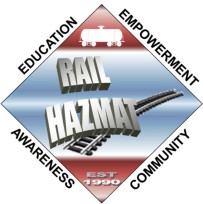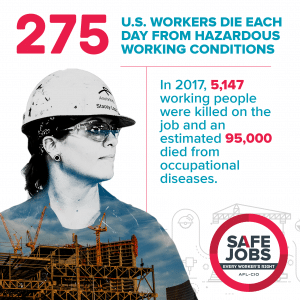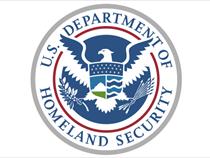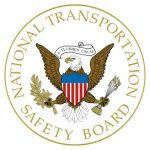Tag: safety
As more people are being diagnosed with COVID-19 or coronavirus, it is important to know who you have come into contact with on a daily basis. State health departments, employers and the infected themselves have been having a difficult time in determining and/or remembering who the infected person may have come into contact with in trying to trace possible infection vectors.
The Bailey Yard in Nebraska was one of the first railroad yards hit with the virus. As the first patient was identified and put into isolation along with other railroad employees who had come into contact with the patient, one thing became clear: not everyone who had come into contact with the infected person had been identified. As a second person was identified as having the virus, the same problem occurred.
“As vice local chairperson, I was getting calls from employees wondering why they weren’t notified as they had been in contact with one or the other of the positive people. I didn’t have an answer, and we discovered that the positive person bears the burden of knowing who they had been around and are asked this days after they’d been in isolation,” said Amanda Snide of SMART Transportation Division Local 200 in North Platte, Neb.
“We potentially come in contact with so many people during our shifts that it can be hard to keep track of who you were with on what days,” she said. “I have been sharing that I am personally keeping track of whom I’ve been in contact with during my shift. During interactions with other employees I explain why I’m writing their names down and encouraging others to do so.
“Whenever someone new calls to be assisted in the process of being taken out of service as they aren’t feeling well, I tell them to start making a list of who they have been around both at work and outside of work. For someone to have been in contact with a sick person, only to find out days after everyone else is pulled from service, would be a sickening feeling that you potentially spread this unknowingly.”
By taking Snide’s advice in writing down names and contact information, we can be sure that we know exactly whom we’ve been in contact with should the worst occur and then can more easily identify others who have come into contact with the virus.
Snide says that in addition to writing down names and contact information, she also takes steps to keep her family safe. Her work boots stay outside, and she doesn’t touch anything in her home until her work clothes are in the washing machine and she’s showered.
As COVID-19 has infiltrated the bus and rail industries, it’s important that members do their best to try to mitigate its spread. As Snide has suggested, we are recommending that all of our members write down who they have come into contact with each day and keep that list for at least a month. Doing so will help identify who may have been exposed if you come down with the virus.
We need to work together to keep ourselves and our union brothers and sisters safe. Another way is by reporting how your carrier is adhering to Centers for Disease Control and Prevention (CDC) protocols.
COVID-19 has hit the transit industry hard with hundreds of cases among passengers and workers alike reported through the media. Only a few cases have been reported on freight carriers thus far, but knowing the conditions that have been reported to the union and the delay by federal agencies to take action, the freight industry could be harder hit. The bus industry has started to report cases as well with Santa Monica’s Big Blue Bus just reporting two cases among their bus operators.
Please see this guide produced by OSHA on how to keep yourself and your co-workers safe, and be careful out there!
In May, the Federal Railroad Administration (FRA) withdrew its proposed rulemaking to require two-person crews on freight trains. The agency then went further and stated that all state laws concerning the subject were preempted by the ruling.
In response, SMART TD President John Previsich testified before the U.S. House Subcommittee on Railroads, Pipelines, and Hazardous Materials in June at a hearing to address the FRA’s decision. In his statement, Previsich described the decision by the FRA as an abdication of its safety oversight duties.
In July, SMART Transportation Division further responded to the FRA by filing a lawsuit with the U.S. Court of Appeals Ninth Circuit Court, asking the court to overturn FRA’s ruling. According to Freightwaves.com, the states of Nevada, Illinois, Washington and California have joined in the fight for two-person crews as well. Nevada, Washington and the California Public Utilities Commission filed petitions with the Ninth Circuit court asking them to review FRA’s decision. Illinois joined the fight for two-person crews August 9, when the state’s governor signed a two-person crew bill into law.
At the SMART TD Regional Meeting in July in San Diego, President Previsich reiterated to members that the union would not take this decision lying down.
“There is going to be a big push coming. We are going to reach out to you when the proper time comes and ask for your assistance,” Previsich told attendees.
Click here to read more from FreightWaves.com.

The classes are to be held Oct. 20-25; Jan. 12-17; Feb. 2-7 and Mar. 15-20, 2020 at the Val Jahnke Training Facility located at 8030 Braniff St., Houston, TX 77061. All classes are from 7 a.m. to 4 p.m. There will be a Sunday evening orientation at 5:30 p.m. the evening before each class starts. This class should only be taken every three years. Please do not register if you’ve done so in the past three years as space is limited.
The Rail Workers Hazardous Materials Training Program was originally funded in 1990 by the National Institute of Environmental Health Sciences (NIEHS) to provide hazardous materials training for rail workers. Since that time, over 27,000 workers have participated in NIEHS-funded training courses that address requirements of OSHA 1910.120 and DOT’s Hazardous Materials Regulations (49 CFR, Part 172, Subpart H). In 2008 the program received additional funding from the US Department of Transportation to conduct Hazardous Material Instructor Training courses.
The funding provides the following student expenses: travel, lodging and meals. In addition, an incentive of $175.00 per day is available to all training participants of these programs, except those who are able to secure regular pay through their employer, or are paid union officers.
Generally, rail workers do not have the same access to quality hazmat and/or basic safety and health training as workers in many other industries. Both FRA and OSHA share jurisdiction in regulating worker safety and health conditions on railroad property. This joint jurisdiction has generally not been integrated into employer-provided training for rail workers, leaving the majority largely untrained or undertrained to safely perform hazmat-related functions consistent with the requirements set forth by OSHA and DOT. This target population of approximately 150,000 conductors, engineers, brakemen, switchmen, carmen, signalmen, laborers, boilermakers, dispatchers, and maintenance of way workers is represented by the nine rail union affiliates of this cooperative effort
The goal of this training initiative is to provide rail workers with the skills and knowledge necessary to protect themselves, the community, and the environment in a hazardous materials transportation emergency. To achieve this goal, the Rail Workers Hazardous Materials Training Program provides rail workers, through quality hazardous materials training courses, the confidence in their knowledge and problem-solving skills to enable them to make the change for safer work conditions.
Much of the training is provided by peer instructors who are full-time rail workers — members and/or local officers of affiliated rail unions.
Click here to register.
The U.S. House of Representatives on Monday, June 24, passed an amendment that would block President Donald Trump’s Executive Order in April to the Department of Transportation to fast-track the allowance of liquid natural gas (LNG) to be transported by rail.
“In its never-ending quest to put profit ahead of people, the Trump administration is now trying to bypass long-standing requirements for transportation of LNG by putting it into 100-car trains that roll through densely-populated areas at upwards of 50 miles per hour,” said U.S. Rep. Peter DeFazio (D – Ore.), chair of the House Committee on Transportation and Infrastructure, who introduced the amendment. “This plan is beyond absurd. Should even one tank car get punctured, the results could be devastating. My amendment blocks this brazen attempt by the administration. I urge the Senate to follow suit and stop a massive catastrophe before it’s too late.”
The Pipeline and Hazardous Materials Safety Administration (PHMSA) moved ahead earlier this month with a plan to authorize six trains, of 100 or more rail tank cars, to move LNG for export through densely populated areas. DeFazio’s amendment would block this special permit as well, which currently is open for comment until July 8.
Read more on this story at Freightwaves.com.
Read an earlier story about the executive order.

According to the AFL-CIO, “Workplace violence is the third-leading cause of death on the job, resulting in more than 29,000 serious, lost-time injuries for workers each year.”
According to the report, in 2017, 5,147 workers lost their lives on the job as a result of traumatic injuries and each day, an average of 14 workers die due to on-the-job injuries. An estimated, 95,000 people die each year from occupational diseases.
The report also states that nearly 3.5 million workers in the public sector had work-related injuries and illnesses, with an additional 2.8 million injuries reported in the private sector. Due to limitations to the current injury reporting system and widespread under-reporting of injuries in the workplace, the AFL-CIO estimates that the true numbers are two to three times greater than these at about 7.0 million to 10.5 million work-related injuries and illnesses per year.
Click here to read the rest of the report from the AFL-CIO.

Of the $345 million recently allocated, Amtrak received $10 million to “protect critical surface transportation infrastructure and the public from acts of terrorism and to increase the resilience of the Amtrak rail system.”
The DHS allocated $88 million to the Transit Security Grant Program (TSGP). “The TSGP provides money to owners and operators of transit systems to protect critical surface transportation and the traveling public from acts of terrorism and to increase the resilience of transit infrastructure.”
Some of the recipients of the TSGP include Dallas Area Rapid Transit ($542,905), SEPTA ($3.6 million), WMATA ($5.4 million), LACMTA ($6.2 million) and many others.
The Intercity Bus Security Grant Program (IBSGP) was allocated $2 million to “assist operators of fixed-route intercity and charter bus services in high threat urban areas to protect bus systems and the traveling public from acts of terrorism, major disasters and other emergencies.”
Click here for a press release from DHS detailing which agencies are awarded funds.
by The National Healthy Sleep Awareness Project
Sleep deprivation impacts workplace safety, productivity and individual health
(DARIEN, Ill.) March 2018 – Getting insufficient sleep and working while fatigued have become commonplace in the modern 24/7 workforce, with more than 37 percent of workers sleep-deprived.[i] Over-worked and over-tired employees experience cognitive declines and present employers with heightened safety risks and increased economic costs. The National Healthy Sleep Awareness Project – including partners the American Academy of Sleep Medicine (AASM), the Centers for Disease Control and Prevention (CDC), the Sleep Research Society (SRS) and the National Safety Council (NSC) – is launching the “Sleep Works for You” campaign, encouraging employers to help workers avoid fatigue and develop healthy sleep habits for long-term success and well-being.
“Working long hours and sleeping less than the recommended seven or more hours has become a badge of honor in many industries, despite evidence that proves a lack of sleep hurts productivity, safety and overall health,” said AASM President Dr. Ilene Rosen. “It is essential for employers to promote health and safety by creating a workplace culture that values the importance of sleep.”
The National Healthy Sleep Awareness Project encourages employers to promote sleep health in the workplace with three steps:
- Learn about sleepiness in the workplace, its costs, its causes and how fatigue can lead to a higher rate of safety incidents
- Educate employees on fatigue, sleep health and sleep disorders, as well as strategies to improve alertness on the job, as part of a comprehensive employee wellness program
- Investigate the causes of fatigue in the workplace and implement fatigue risk management as part of a safety management system
“Nearly 70 million Americans suffer from a sleep problem, and nearly 60 percent of them have a chronic disease that can harm their overall health,” said Janet B. Croft, PhD, senior chronic disease epidemiologist in CDC’s Division of Population Health. “Lack of sleep and sleep disorders, including stops in breathing during sleep (sleep apnea), excessive daytime sleepiness (narcolepsy), restless legs syndrome, and insomnia, are increasingly recognized as linked to chronic disease, including obesity, high blood pressure, and cancer.”
The Cost of Fatigue
According to the NSC, fatigued workers cost employers about $1,200 to $3,100 per employee in declining job performance each year, while sleepy workers are estimated to cost employers $136 billion a year in health-related lost productivity.
To help employers gauge how much fatigue may be adding to annual expenditures, NSC and Brigham and Women’s Hospital created an online Fatigue Cost Calculator.
“Sleepless nights hurt everyone,” said NSC President and CEO Deborah A.P Hersman. “Many of us have been conditioned to just power through our fatigue, but worker health and safety on the job are compromised when we don’t get the sleep we need. Doing nothing to address fatigue costs employers a lot more than they think.”
Impact of Sleepiness on Safety
Sleepiness causes decreased performance capacity, and tired workers become slower, more error prone and less productive. Research shows that fatigue impairs employees’ ability to function properly and puts them at a greater risk of a safety incident.[ii] In fact, about 13 percent of work injuries are attributable to sleep deprivation.[iii]
Sleepiness also impacts safety for those who drive as part of their job or commute to and from work. The National Transportation Safety Board (NTSB) estimates that fatigue has been a contributing factor in 20 percent of its investigations over the last two decades. That’s why the NTSB included “reduce fatigue-related accidents” on its 2017 – 2018 Most Wanted List of transportation safety improvements.
In February, the AAA Foundation for Traffic Safety released a research brief estimating that drowsy driving is involved in up to 9.5 percent of all motor vehicle crashes. Projections from the AAA Foundation indicate that drowsy driving causes an average of 328,000 motor vehicle accidents in the U.S. each year, including 6,400 fatal crashes.
Maximizing Health of Shift Workers
The effects of sleepiness are exacerbated and pose a constant struggle for workers who work night shifts or rotating shifts, and for those who work long hours or have an early morning start time. U.S. Bureau of Labor statistics show about 15 percent of full-time employees in the U.S. perform shift work, many of whom suffer from chronic sleep loss caused by a disruption in the body’s circadian rhythm. Chronic sleep deprivation is associated with an increased risk of depression, obesity, cardiovascular disease and other illnesses that negatively impact a worker’s well-being and long-term health.
There are significant differences in the rate of insufficient sleep among occupations. A recent CDC analysis found that the jobs with the highest rates of short sleep duration were communications equipment operators (58.2%), other transportation workers (54.0%) and rail transportation workers (52.7%).
Night shift workers and those driving during nighttime hours are most at risk for chronic sleep loss. The NSC found that 59 percent of night shift workers reported short sleep duration compared to 45 percent of day workers, while the risk of safety incidents was 30 percent higher during night shifts compared to morning shifts.
Employers with personnel in safety-sensitive positions are urged to implement a fatigue risk management system. The National Institute for Occupational Safety and Health (NIOSH) provides educational resources on sleep, shiftwork, and fatigue for employees and managers involved in aviation, emergency response, healthcare, railroads and trucking.
Employers can help shift workers fight fatigue by implementing the following strategies:
- Avoid assigning permanent night-shift schedules
- Assign regular, predictable schedules
- Avoid long shift lengths
- Give employees a voice in their schedules
- Rotate shifts forward when regularly changing shifts
- Provide frequent breaks within shifts
For more information on how to keep employees safe from risks and costs of fatigue, please visit www.projecthealthysleep.org.
###
About the National Healthy Sleep Awareness Project
The National Healthy Sleep Awareness Project was initiated in 2013 and is funded by the Centers for Disease Control and Prevention through a cooperative agreement with the American Academy of Sleep Medicine. The project involves collaboration with the Sleep Research Society and other partners to address the sleep health focus area of Healthy People 2020, which provides science-based, 10-year national objectives for improving the health of all Americans. The sleep health objectives are to increase the medical evaluation of people with symptoms of obstructive sleep apnea, reduce vehicular crashes due to drowsy driving and ensure more Americans get sufficient sleep. For more information, visit www.projecthealthysleep.org.
[i] Yong LC, Li J, Calvert GM. “Sleep-related problems in the US working population: prevalence and association with shiftwork status.” Occup Environ Med Published Online First: 08 September 2016. doi: 10.1136/oemed-2016-103638
[ii] Lombardi, D. A., Folkard, S., Willetts, J. L., & Smith, G. S. (2010). Daily sleep, weekly working hours, and risk of work-related injury: US National Health Interview Survey (2004–2008). Chronobiology international, 27(5), 1013-1030
[iii] Uehli, K. “Sleep problems and work injuries: a systematic review and meta-analysis.” Sleep Med Rev. 2014 Feb;18(1):61-73. doi: 10.1016/j.smrv.2013.01.004. Epub 2013 May 21.

The Federal Railroad Administration (FRA) received one urgent safety recommendation based on NTSB findings in the agency’s investigation of the Feb. 4, 2018, collision of an Amtrak train and a CSX train near Cayce, S.C. The conductor and engineer of the Amtrak train died as a result of the collision. The NTSB issued two urgent safety recommendations to the Metropolitan Transportation Authority (MTA) based on findings from its investigation of the June 10, 2017, Long Island Rail Road (LIRR) accident in which a roadway worker died near Queens Village, N.Y.
In the investigation of the train collision in Cayce, South Carolina, investigators found that on the day before the accident, CSX personnel suspended the traffic control signal system to install updated traffic control system components for the implementation of positive train control (PTC). The lack of signals required dispatchers to use track warrants to move trains through the work territory.
In this accident, and in a similar March 14, 2016, accident in Granger, Wyo., safe movement of the trains, through the signal suspension, depended upon proper switch alignment. That switch alignment relied on error-free manual work, which was not safeguarded by either technology or supervision, creating a single point of failure.
The NTSB concludes additional measures are needed to ensure safe operations during signal suspension and so issued an urgent safety recommendation to the FRA seeking an emergency order directing restricted speed for trains or locomotives passing through signal suspensions when a switch has been reported relined for a main track.
“The installation of the life-saving positive train control technology on the CSX tracks is not the cause of the Cayce, S.C. train collision,” said NTSB Chairman Robert Sumwalt.
“While the collision remains under investigation, we know that signal suspensions are an unusual operating condition, used for signal maintenance, repair and installation, that have the potential to increase the risk of train collisions. That risk was not mitigated in the Cayce collision. Our recommendation, if implemented, works to mitigate that increased risk.” said Sumwalt.
During the investigation of the LIRR accident, the NTSB identified an improper practice by LIRR roadway workers who were working on or near the tracks. LIRR employees were using “train approach warning” as their method of on-track safety, but they did not clear the track, as required, when trains approached and their “predetermined place of safety” did not comply with LIRR rules and procedures.
The NTSB is concerned LIRR management is overlooking and therefore normalizing noncompliance with safety rules and regulations for proper clearing of tracks while using “train approach warning” for worker protection. The two urgent safety recommendations to the MTA call for MTA to audit LIRR’s use of “train approach warning” for worker protection, and, to implement corrective action for deficiencies found through the audit.
The full safety recommendation reports for these urgent safety recommendations are available online at https://goo.gl/z87Dpz and https://goo.gl/LVVef3.